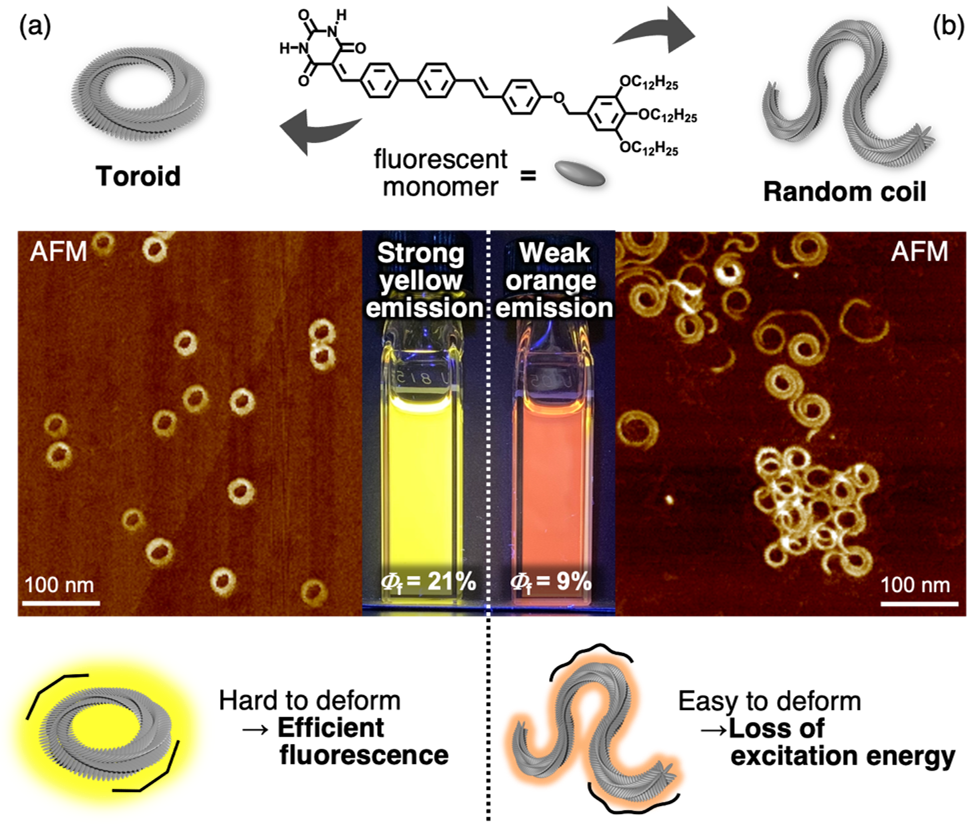The self-assembled state of the molecules determines the characteristics of supramolecular polymers. On the other hand, nothing is understood about how morphologies affect the characteristics of polymeric assemblies at the nano- and mesoscopic scales.

(a) The toroidal assemblies with no termini are not easily deformed in solution, resulting in less excitation energy loss and strong yellow fluorescence. (b) The randomly coiled assemblies are easily deformed, resulting in excitation energy loss and a weak orange fluorescence. Image Credit: Sho Takahashi from Chiba University, Japan
Recently, a group of researchers showed that random coils and terminus-free toroids produced from the same luminous molecule exhibit distinct photophysical characteristics. Additionally, the group introduced a brand-new technique for cleaning the toroidal structure.
In supramolecular chemistry, a molecule’s tangible characteristics are largely determined by its state of self-assembly. A lot of research has been focused on controlling the self-assembled state since it can be used to create materials with specific characteristics like charge transport capacity and fluorescence wavelength.
Researchers have been attempting to understand the effects of molecular organization on supramolecular assemblies in the mesoscopic (10–1000 nm) and nano (<10 nm) length scales for many years. However, dynamic structural changes and immature control over self-assembly sometimes impede the investigation of structures with supramolecular polymer assemblies originating from the same monomer.
A new investigation on the characteristics of one-dimensional mesoscale supramolecular assemblages of two distinct structures made of the same luminescent molecule was published on January 1st, 2024, in the Journal of the American Chemical Society. It demonstrated how the presence or absence of a closed circular pattern in two structures’ molecular arrangements affected their very different attributes.
Professor Shiki Yagai of Chiba University oversaw this study, and the study’s first author was Sho Takahashi, a doctorate candidate at Chiba University’s Graduate School of Science and Engineering. Dr Hikaru Sotome from Osaka University's Graduate School of Engineering Science and Prof. Martin Vacha from Tokyo Institute of Technology’s Department of Materials Science and Engineering were the study co-authors.
The geometrical beauty of a circular structure, which has no termini and no corners, has fascinated people. Chemists have realized the synthesis of giant cyclic molecules using various approaches not only to create beautiful structures but also to compete in the elegance of the process of synthesizing such beautiful structures.
Shiki Yagai, Professor, Chiba University
Yagai added, “The best example of nature utilizing the functional beauty of circular structures would be the light-harvesting antenna organ (LH2, LH1) of purple photosynthetic bacteria. LH2 has a beautiful circular structure due to the protein’s outstanding self-organizing ability, and it is thought that by arranging chlorophyll dyes in a circular array based on this framework, lean light collection and excitation energy transfer are achieved.”
The researchers produced a combination of two one-dimensional π-conjugated molecular aggregates with distinct shapes—that is, terminus-free cyclic structures (toroids) and randomly coiled structures—by allowing luminous molecules that they had synthesized based on their molecular design to self-assemble. Low-energy and low-intensity luminescence were displayed by the combination.
A unique dialysis approach was employed to separate the two complexes by taking advantage of the disparity in their kinetic stability. After separation, it was demonstrated that, in contrast to random coils, the terminus-free closed toroidal shape produced more energy and more effective luminescence. The group used ultrafast laser spectroscopy to look at the process behind their fluorescence qualities, which are reliant on topology.
The findings showed that, in contrast to toroids, which were not readily deformed and displayed fluorescence without energy loss, random coils with termini lost excitation energy as a result of flaws caused by fluctuations in solution.
Additionally, it was discovered that only the luminescence obtained from the random coil was visible in the mixed solution of toroids and random coils because the excitation energy was transferred from the toroid to the random coil as a result of the agglomeration of both assemblies.
The morphological management of materials at the mesoscale is established in this work as a potential new design guideline for functional materials. It also emphasizes the necessity of purifying assemblies before examining their photophysical characteristics when dealing with materials that are susceptible to supramolecular polymorphism, such as random coils and toroids. The findings produced from energy transfer across diverse structures can simply represent biased qualities rather than distinct ones if the structures are not separated.
The objective of the researchers is that these discoveries will stimulate the creation of flexible electronics with great performance through the use of cyclic molecular assemblies.
Financial support for this study was provided by the Mitsubishi Foundation (grant no. 202110037), the JST SPRING grant no. JPMJSP2109, the Japan Society for the Promotion of Science (JSPS) KAKENHI grant nos. JP22H00331, JP23H04873, JP23H04875, and JP23H04877 in a Grant-in-Aid for Transformative Research Areas “Materials Science of Meso-Hierarchy.”
Journal Reference
Takahashi, S., et. al. (2024) Impact of Ring-Closing on the Photophysical Properties of One-Dimensional π-Conjugated Molecular Aggregate. Journal of the American Chemical Society. doi:10.1021/jacs.3c11407